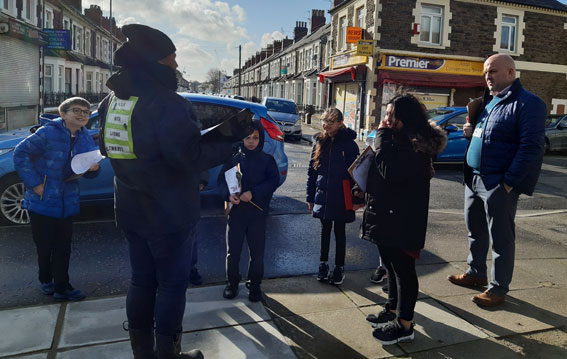CARDIFF – HEALTHY STREETS IN A GROWING CITY
Cardiff is set to grow significantly over the next decade, and the city's council knows the way people travel will need to change as a result.
It wants active travel - walking, wheeling and cycling - to be at the heart of its transport plans.
To support this, we've been working with residents and others to identify ways to create healthy, safe and accessible streets.


THE VISION FOR CARDIFF - STREETS FOR HEALTH
We support more active travel everywhere in Wales, but the scale of growth planned for the capital means there's a particular need to make big changes.
We need to move away from car use, and towards more walking, cycling and public transport.
Providing the infrastructure to support this change is central to Cardiff Council’s Transport White Paper. The council says it's a 'bold agenda to transform Cardiff's transport network to help tackle climate change, improve air quality and promote better health.'
It includes a commitment to rolling out a ‘Streets for Health’ initiative across the city, enabling all streets to be reclaimed as public spaces, and become:
- Healthy and green,
- Safe and child friendly,
- Good for walking and cycling
- Biodiverse with planting and sustainable urban drainage systems
- More accessible for everyone, particularly those with restricted mobility.
The council commissioned Living Streets Cymru, working with creative research and design practice Urban Habitats, to carry out a pilot project. The idea was to identify small scale, high impact changes which would support the transformation to healthier streets across the city.
THE PILOT PROJECT
Our pilot project was based in the Plasnewydd area of Cardiff, a suburb of terraced streets just outside the city centre.
Like many urban communities, the district has suffered from the effects of motor traffic. It's a problem local resident Peter, who's lived in Plasnewydd for 16 years, knows very well:
“Roath has struggled with excess traffic for years, particularly rat-running on the residential streets" he told us. "In addition, our main shopping streets are noisy and congested, often with narrow and uneven pavements."
To improve the situation and make the project a success, it was important that we developed a good understanding of the area and spoke to a wide range of local people.
We began by looking at Plasnewydd in detail, examining data and holding a workshop with a wide cross-section of council officers.
The next phase was working with the community. We wanted to gain an insight into what people living there think about their streets, and the things they would like to change.
Our activities included drop-in sessions, street and school route audits and an online survey.
We involved residents, business owners, the local school and politicians. We ran activities at different times of the day and week, using a wide range of methods, to ensure an inclusive approach.


A NEW LIVING STREETS GROUP
As part of the legacy of this project, we encouraged residents to come together as a Living Streets Local Group and the Roath and Plasnewydd group was formed.
Peter became a founding member of the new group, and has high hopes for what it can achieve:
“We’re attracting a lot of support from across the community via our social media channels, we’ve established a good working relationship with the council and a local school, and we’re getting things done. It’s very encouraging to see!”
NEXT STEPS
We presented our recommendations to Cardiff Council in Spring 2020, and it says the findings have "provided a helpful indication of the improvements that could be implemented that would enhance local streets and provide a healthy environment to live in."
The council says the engagement work has "generated a lot of local interest and highlighted the potential for a community-led initiative in Plasnewydd".
It's also setting up a working group to enable the initiative to take shape, paving the way for the roll out of further 'streets for health' projects across other parts of the city.

WALKABLE NEIGHBOURHOODS
The lower the traffic on a street, the more community interaction and healthy physical activity we see.
OUR SERVICES
Our 90 year history as the voice for pedestrians has made us experts on liveable neighbourhoods.
We have a range of services – both advisory and consultative - which help make places for people, and we help local authorities create more walkable streets.
